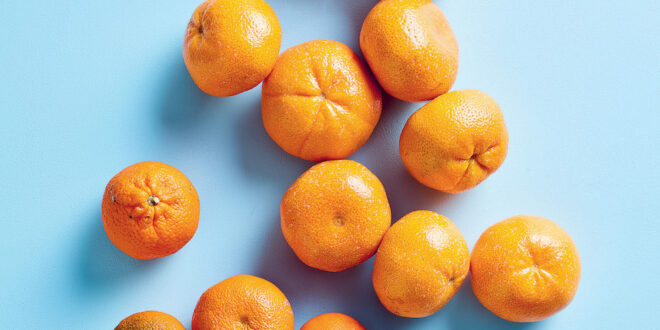 Extracted with permissions from Don’t Buy Fruit and Vege Without Me by Thanh Truong, Macmillan Publishers, RRP $44.99
Extracted with permissions from Don’t Buy Fruit and Vege Without Me by Thanh Truong, Macmillan Publishers, RRP $44.99
Compared to oranges, mandarins have looser skin and pith making them easier to peel and break into segments. They also have less acid, meaning they’re usually sweeter, and have a stronger perfume, especially from the oils in the peel. I only ever remember eating imperial mandarins in Australia when I was young, but now there is a raft of competitor varietals, all with their own unique flair. Some are bigger with thinner segment walls; others are juicier to the point of being watery; and some are more plump and full. The world of mandarins is vast, and most hybrid mandarins marketed today, such as tangerines, murcotts, clementines, afourers, novas and tangelos, carry specific desirable traits. Mandarins are the ultimate convenient citrus fruit, and they were a favourite in my lunchboxes at school.
A quest for juicy mandarins
I once travelled to Gayndah, Australia’s mandarin capital, as I was providing translation services for some of our business partners from China who had come to purchase our prized Australian fruit. On this occasion I got to meet up with Brent Chambers, who I’d previously worked with in the avocado industry. Gayndah Packers, or Gaypak, are historically one of the largest mandarin packers in Australia and most of us have probably eaten a mandarin or two packed by Gaypak in our lifetime. You know you’ve entered mandarin country when you drive past the ’big mandarin’.
Brent knows mandarins; he was the operations manager and general manager in the region for more than a decade and organised everything from farm to supermarket. We discussed honey murcotts, imperial mandarins, seeded versus seedless varieties, flavour and juicy fruit. When discussing fruit with a high water content, or ’juicy’ fruit, we also talked about mandarins that eat dry. This unfortunate dry flesh in citrus is called ’granulation’, and it’s something the industry still struggles to address today. Granulation affects all citrus but is particularly evident in some mandarin varieties. The juice sacs dry up either while the fruit is on the tree or after it has been harvested. I’m sure we’ve all eaten a dry, lacklustre mandarin before and they’re not a great experience.
While discussing the contentious debate of puffy versus tight-skinned imperial mandarins, Brent proclaimed that both eat the same with one big exception: late in the season, large puffy mandarins tend to become very dry. It’s this little piece of information that had me completely excited – a hint! A trail to follow and a piece of information about mandarins that no one else had ever told me.
Several weeks later, the mandarin season was reaching its end and I started looking for large puffy imperial mandarins at the fruit shop so I could analyse the fruit and compare it to tight-skinned mandarins. As I firmly grasped and then tossed puffy and tight-skinned mandarins back on the fruit display, I noticed that some were heavier than others. If you’re unaware, all mandarins are packed by box, and every box has a ’count’ on them. The count represents the number of mandarins in each box, so the greater the number, the smaller the size of the fruit; conversely, the smaller the count, the bigger the fruit.
On this occasion the mandarins were large. The puffy imperial mandarins in the box were relatively light, while the tighter-skinned imperial mandarins felt a touch heavier. I bought a mixture of both to sample and, as Brent informed me, the puffy mandarins were indeed mostly dry. The next day I went to a different fruit shop for work and they were ranging small mandarins. I decided to buy only tight-skinned heavy fruit to test and used my hand to feel the nuance in weight. It’s probably worth noting that I touch fruit at least a hundred times a day, so it’s easy for me to identify small changes in the weight of the fruit. I picked a light mandarin and to my amazement the fruit had granulation. I then picked a heavy mandarin and it was juicy. This tip has never failed me and it applies to the whole citron family. Armed with this information, you need never pick a dry citrus fruit of any variety again!
I learned from my father that sometimes deep knowledge of a fruit takes a lifetime of work and a desire towards continuous improvement to obtain. I have seen my father discover nuances about fruit and vegetables no one else could possibly know, and it’s this that makes him a special fruiterer.
While translating the desires of the buyers in Gayndah, there was a strong emphasis on the premium market honey murcott needing to be seedless. When I was a kid, nearly all the oranges I ate had large seeds and most mandarins had some seeds, which you had to spit out. In the last three decades the most commercially grown varietals of citrus are seedless, and in the future we are probably going to see more citrus varieties without seeds, especially in the mandarin category.
The idea of citrus being seedless is a relatively modern one in the citrus industry, and the privilege of convenience really does elevate the premium on a fruit.
My best mandarin experience
When I exhibited at the Fruit Logistica in Berlin, the world’s biggest fruit industry gathering and exhibition, I met Jim Im who is now one of my best fruit mates. He’s a second-generation Jeju Island mandarin farmer who travelled to Australia and worked picking oranges tirelessly in the Aussie heat, working his craft. He now exports Korean fruits around the world and is the largest exporter of Jeju Island mandarins, thanks to his family’s connection to the island and grower community. In the middle of a -10°C snow storm in Berlin, Jim handed me a redhyang mandarin grown on Jeju Island. It was a life-changing experience. The segments were big, the segment walls were thin and tasty, the internal pulps were juicy and separable like a pomelo, with an intense sour flavour only outdone by the sweetness, and the aroma in each bite was like scratching the peel over and over again.
When I travelled to Jeju Island I noticed many other mandarin varietals in the Seogwipo pack houses that were sold with greencoloured skin. It’s important to note that depending on the varietal and the country, many citrus industries across the world do force citrus, such as oranges, mandarins and lemons, to a have uniform skin colour, and this dispels any myths that the colour of the skin is an indicator of a fruit’s ripeness. Don’t be deceived by your eyes; use my handweighing technique instead. You cannot imagine how heavy the redhyang variety was!
The core of the problem
I’ve eaten hundreds of mandarins from Egypt, the United States and Australia and I’ve encountered many varietals that tend to have a thick central core thread and a stringy segment edge. This part of the fruit anatomy annoys me, as when you break apart an individual mandarin segment you’re left chewing the pith. I discovered the best way to achieve a great mouthfeel is to remove this thread and any attached thick pith on the segment edge. This can be done with a pair of scissors and is a labour of love, but, if you ask me, it’s worth it. You’ll have a much better experience that will leave you wanting to eat more mandarins than you originally set out to. Removing the thread means that when you initially bite into the mandarin segment, the gush of juice is linear and hits the side or back of your mouth, giving you a burst of zest and juice. It also removes any stringy fibres and makes the side segment walls much easier to chew and swallow. An elevated mandarin eating experience is one that my two kids love. I can even offer sub-optimal mandarins cut in this fashion and my kids will eat them … sometimes!
Much more than a fruit
Mandarins originate from China and having Chinese heritage means the fruit has always had a special meaning to my family. During Lunar New Year we would often seek out mandarins to put on the altar. The Chinese word for mandarin – ’júzi’ (橘子) – is very similar to the word for gold – ’jīnzi’ (金子) – and even the hue of the fruit is akin to gold. This is why mandarins have an auspicious connection to wealth, and placing them on the altar represents our desires for wealth in the coming year.
Mandarins, and specifi cally the peel – ’chén pí’ (陈皮) – have been an important part of Chinese culture and the culinary repertoire for thousands of years. Some mandarins in China are grown specifi cally just for the peel on the skin, which is dried and either cooked in dishes or used in other fascinating ways. The last time I travelled to Chao Zhou in Guangdong province, where my great grandparents were from, I purchased individual tea gifts. A teaspoon of tea leaves was placed delicately in a brown dried mandarin peel, still in its spherical shape, with the peel releasing a beautiful perfumed aroma from the intense oils in the dried skin.
Choose
1. Do the weight test: select two mandarins of the same size – the heavier mandarin will have more water content and therefore be juicier, while the lighter mandarin may have granulation.
2. To pick seedless segments, hold the peeled segment up to the light to see if there are any seeds.
Store
Store mandarins in a plastic bag or airtight container, to prevent them drying out, in the fridge (ideally 5°C). Because a mandarin’s skin is much thinner and more permeable than an orange, it will dehydrate faster and have a much shorter shelf life if not stored correctly.










Join the Discussion
Type out your comment here:
You must be logged in to post a comment.